My WINGS tour to
Baja California’s Cape Region includes a boat trip on Bahia Magdalena, leaving
from Puerto San Carlos west of Ciudad Constitucion. This is about a 4-hour
drive from La Paz, and on our way we made a stop in the unique desert of the
Magdalena Plain.
One of the
most distinctive features one notices in this type of desert are the lichens
growing on everything. Fog is common here at any time of year, though rains are
infrequent and unpredictable.
This is Lophocereus schottii, Senita Cactus,
which barely makes it into the U.S. at Organpipe Cactus National Monument.
I was
especially hoping to find a patch of the cactus Stenocereus eruca, the Creeping Devil, endemic to this particular
area. I had seen it a couple years ago on a side road we didn’t have time to
check this year, and back then I didn’t realize how local an endemic it is. We
couldn’t find it, unfortunately. But the plants, birds, and animals here were
good. A pair of Harris's Hawks let us approach quite closely.
This male Costa's
Hummingbird appeared out of nowhere, seemed to choose a perch to check us out
for a minute, then zoomed off.
When I saw
this lizard run on the sand and hide under a bush, I assumed it had to be the drab
local subspecies of Zebra-tailed Lizard, but Brian Eagar explained to me that
it’s a female of the extremely variable Uta
stansburiana, Side-blotched Lizard – despite the lack of a blotch.
About 15 km
before we reached the coastline of Magdalena Bay we started seeing Ospreys on
their nests on transmission line pylons as well as on the many platforms
erected for them. There is an active nest every few hundred meters after this.
I’d be surprised if there were a denser breeding population anywhere else in
the world.
This
pond just before Puerto San Carlos
is a roost for many ibises, herons, and egrets, and we watched about 100 birds
come in at sunset, including an impressive total of 14 Reddish Egrets.
This is also
where we finally got good views of this Ridgway's Rail, a recent split from
Clapper Rail. The Baja California Sur endemic subspecies here is Rallus obsoletus beldingi, which
supposedly looks different or has different measurements from the subspecies in
California, Arizona, mainland Mexico.
The main
purpose of our big detour this far north is to take a whale watching trip on
Bahia Magdalena. The day started with thin low-level fog, the first time I’ve
seen that here. But it burned off very quickly, and the nearly perfectly still
air (one reason for the fog) resulted in a gorgeous, nearly flat and mirror-like
sea.
We saw
whales – at one point one could scan a 90° swath ahead and see about 15 whale
spouts in the distance. As we got closer to the main area of activity, we had
very good views of several whales and their flukes: Eschrichtius robustus, the Gray Whale.
After about
an hour of waiting (and never aggressively approaching any), we found ourselves
next to what appeared to be a mating orgy, with three or four individuals
flailing about. In this one shot, you can even the see the penis of one whale
as he rolls on his back.
There was
some exciting birding too. Before we even got to the whales, I directed José,
our pilot to motor towards a group of plunge-diving Brown Pelicans. As we got
closer, I noticed several Black-vented Shearwaters amongst the group, the first
I have seen in the bay. I quickly made sure my group could see them, then tried
getting some photos, vaguely aware that there were some small dolphins in part
of the feeding frenzy. To my surprise, I got not only an in-focus photo of one
of the shearwaters in flight (not very easy with the Canon PowerShot type
cameras), but also an identifiable shot of what turned out to be a Delphinus capensis, Long-beaked Common
Dolphin.
On our way
back to port we came across a resting group of Black-vented Shearwaters,
allowing excellent views.
Out of
nowhere came a Pomarine Jaeger, which briefly chased one of the shearwaters and
then quickly vanished to the south. One of my participants got much better
photos than this – this is more typical of the kind of photo I can get of a
bird in flight with this camera.
José paused
to show us several of these young Urobatis
halleri, Round Stingrays, common in the shallower parts of the bay.
-->
With only a
few effortless flaps and no wind, this Brown Pelican skimmed the surface of the
water and passed us.



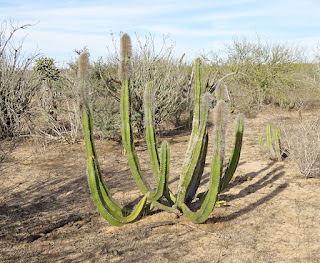



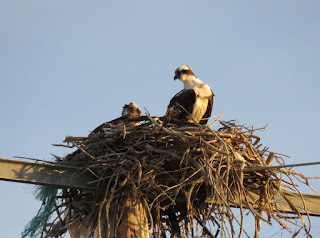

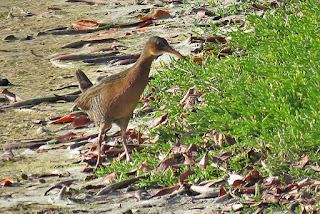




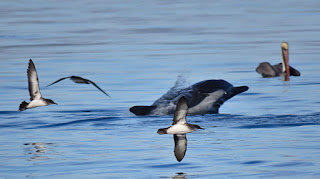



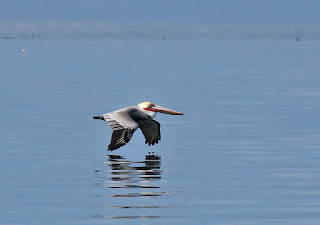





No comments:
Post a Comment